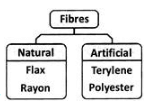Olympiad Test: Fibre to Fabric - Class 5 MCQ
20 Questions MCQ Test Advance Learner Course: Science Class 5 - Olympiad Test: Fibre to Fabric
Which of the following sequences is correct in making fabric?
Which of the following devices was popularized by Mahatma Gandhi as a part of the independence movement?
Which of the following materials is grouped wrongly in the chart given below?


Which of the following processes involves rotting of gummy skin of jute sticks in water?
Which of the following fibres on burning smells like burning hair?
The box given below shows the characteristics of fibres. Fabric made from above fibre is comfortable to use during which of the following seasons?

Which of the following is used to make carpets and gunny bags?
Which of the following does not belong to the group formed by others?
Complete the given correlation
Silk : Cocoon Wool : ?
Which part of the cotton plant yields cotton bolls?
Which of the following processes involves the separation of seeds from cotton bolls?
Which of the following is made from coconut fibres?
Which of the following are the two main processes of making fabrics?
Which of the following statements is true for weaving?
Which of the following processes involves conversion of yarn into cloth?
Which of the following takes place when fibres are twisted before being made into yarns or thread?
Which of the following is formed when fibres are twisted by spinning?
Fibres made from which of the following is suited to be used in cold places?
|
26 videos|28 docs|9 tests
|














